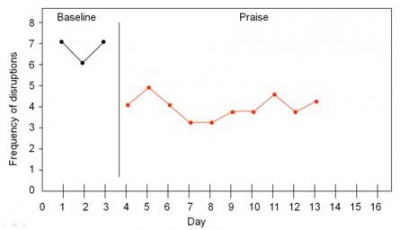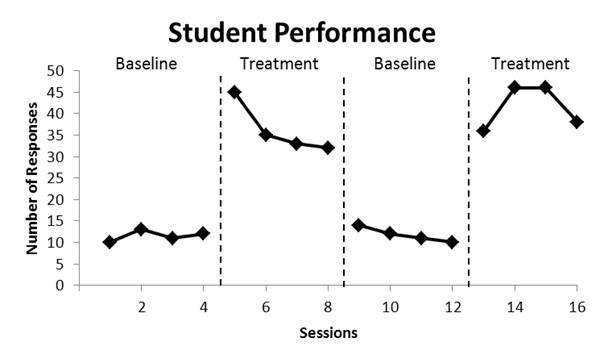The letter B is the introduced intervention. Any systematic attempt to identify sources of reinforcement for problem behavior Functional analysis FA.
Single Subject Research Designs Research Methods In Psychology 2nd Canadian Edition
They are of 3 types namely.

. Similarly an implementation strategy may be used to encourage the use of a. ABA and ABAB are not acronyms as such but refer to the stages of the model. ABA design also known as a withdrawal or reversal design is a type of single subject experimental design which allows researchers to investigate the effectiveness of an intervention.
Applied behavior analysis relies on experimentation to assess the efficacy of interventions. This entry first describes ABA designs and provides an example then discusses phase changes in ABA designs how ABA designs are. Byiers et al 2012 including withdrawal designs and alternating treatment designs that can be used in testing evidence-based practices.
Experimentation involves the measurement of one physical event the dependent variable under conditions where the value of a second physical event the independent variable is manipulated systematically. Example in clinical context. If all factors have 2 levels we have a 2 k factorial design.
Evidence-Based Practice137 Ethical Issues Unique to Experimental Research 13 9. Six primary design types are discussed. Two types of non-reversal multiple baseline designs are discussed here.
The pre-experimental or AB design the withdrawal or ABAABAB design the multiple-baselinemultiple-probe design the changing-criterion design the multiple-treatment design and the alternating treatments and adapted alternating treatments designs see Table 2. Reduce the no. Designs to Monitor Programs 13 4.
With the passage of timeboth the large sample and single-subject procedures have become better developed and their strengths and weaknesses more apparent. Pre-experimental quasi-experimental and true experimental research. The classroom and in the hallway.
Single-subject experimental designs also referred to as within-subject or single case experimental designs are among the most prevalent designs used in CSD treatment research. Use a fraction of the full factorial design. Nonequivalent Control Group Designs.
A represents the initial unaltered behavior and that becomes a baseline for the study. Types of Experimental Designs. We also note that there are a variety of Single Subject Experimental Designs SSEDs.
Participants was established focusing on applied research and entitled Journal of Applied Behavior Analysis. Use fractional factorial designs. An experimental design where implementation of the intervention is staggered in a stepwise fashion across behaviors settings and subjects.
Continuous Bx changes ovr time reqs cont. Leading Provider of ABA Therapy. The most basic single-subject research design is the reversal design also called the ABA design.
Use of the experimental model to. 4 Types of Experimental Designs. The A-B1-A-B2-A-Bn design is useful when the aim of the researcher is to study the effects of different levels of a specific independent variable.
Single Subject Experimental Designs and On-Off-On ABA Designs. If the value of the dependent variable covaries. These methods continue to evolve as do other research methods.
Types of study designs include. The B-A-B design is used in situations when studying an intervention or treatment which is already in progress. Reduce the number of factors.
ABA designs typically start with a baseline period where behaviour is monitored before an intervention stage where behaviour is monitored whilst a treatment is administered. The effect of an independent variable is easier to detect when the noise in the data is minimized. These research designs proceed from a level of high validity and generalizability to ones with lower validity and generalizability.
Reducing Cost of Full Factorial Design. Multiple group design is a type of experimental design in which the independent variable has a. RESEARCH DESIGNS IN ABA 4 Withdrawalreversal design is characterized as a design treatment program that gathers data on a baseline target behavior then introduces an intervention to effect that baseline behavior whether negative or positive and to see if it changes then you remove the intervention and go back to the baseline behavior and then begin the.
Types of Experimental Designs - -ABAB Replication Reversal Design-Multiple Baseline Design-Changing Criterion-Alternating Treatments Design Multiple Baseline Designs - Establish experimental control through seeing change sequentially on different dimensions. Multiple baseline alternating treatments reversal and changing criteria designs. ABA designs also known as reversal designs are among a family of single-case experimental designs most often used by behavioral scientists and educators to evaluate the effectiveness of clinical or educational interventions.
These designs provide a framework for a quantitative scientifically rigorous approach where each participant provides his or her own experimental control. - BX is a natl phenomenon and subject to the same natl laws as other natl. Types of Nonexperimental Designs.
The behavior analyst begins to collect. At ABA Connect our commitment is to provide the industrys best evidence-based ABA therapy services to our clients to dramatically improve the quality of their lives. Of levels of each factor.
ABA and Multiple-Baseline Designs. This model is a form of a research protocol called Single Subject Experimental Design. Four major design types with relevance to user research are experimental quasi-experimental correlational and single subject.
In pre-experimental research design either a group or various dependent groups are observed for the effect of the application of an independent variable which is presumed to cause change. Recall that we encountered this same principle when discussing experimental research more generally. Implications for Evidence-Based Practice Diversity Group Design and.
A behavior analyst wants to target a students dropping behavior in two different settings. Anecdotal Indirect Methods Descriptive Naturalistic Analysis Functional Experimental Analysis 11 Simplicity Most LeastMost Precision Least Terminology Functional behavioral assessment FBA.

Aba Experimental Designs Behavior Analysis Aba Therapy Bcba

Pass The Big Aba Exam Chapter 5 Experimental Design Flashcards Quizlet

Pass The Big Aba Exam Chapter 5 Experimental Design Flashcards Quizlet

Aba Experimental Design And Timeline Example A Experimental Design Download Scientific Diagram
D 5 Use Single Subject Experimental Designs E G Reversal Multiple Baseline Multielement Changing Criterion C Learningbehavioranalysis Com

Single Subject Research Educational Research Basics By Del Siegle

0 komentar
Posting Komentar